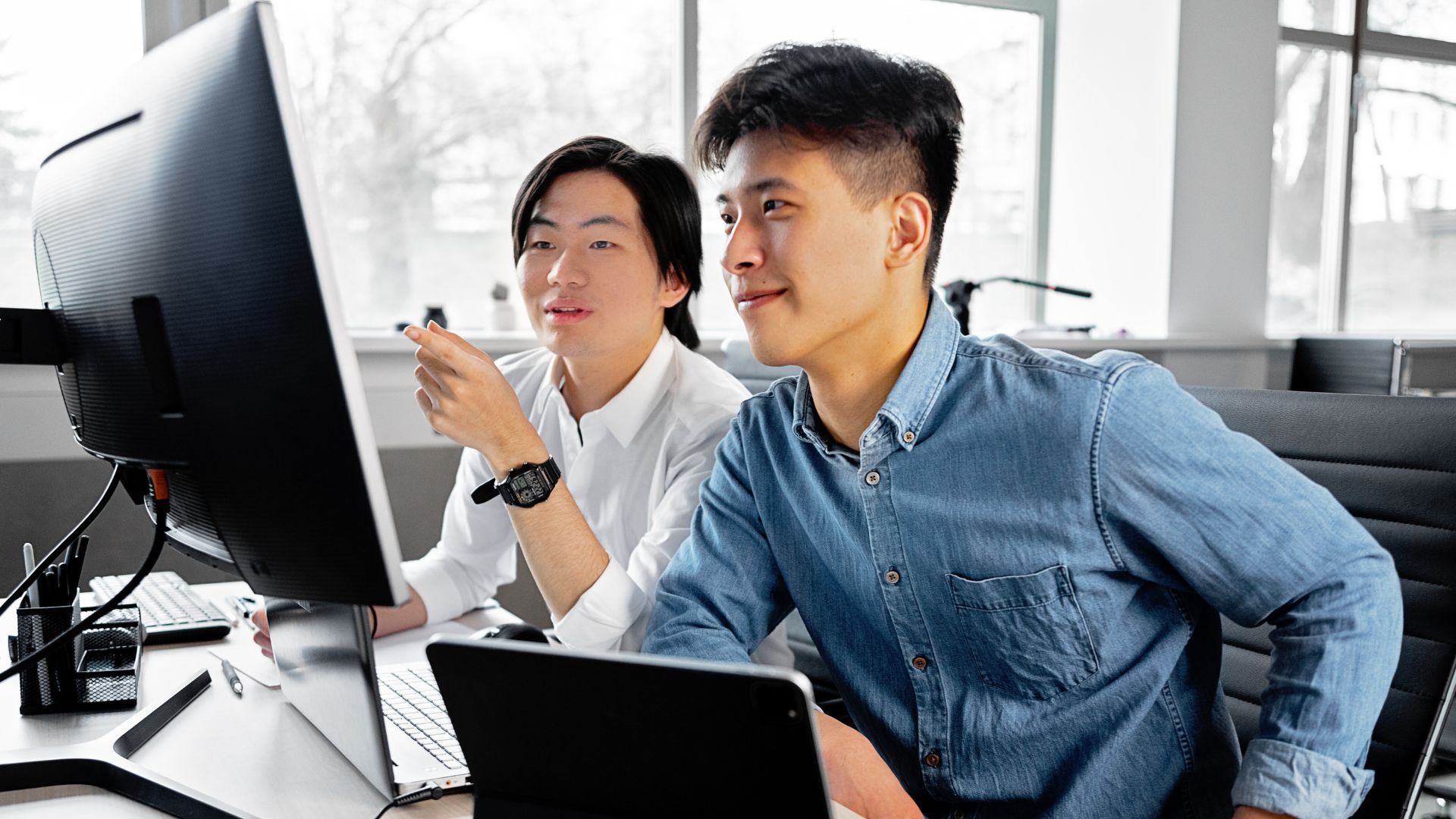What you need to know about separation anxiety in dogs
PETstock • September 5, 2022

Australia, the search is on.
For its 2nd consecutive year, people2people, along with our headline sponsor
PETstock, and new sponsor
DRONTAL, is proud to celebrate 2022 #OZTOPDOG.
Enter your four-legged best friend into our 3 prestigious awards categories: OZ Top Dog with a Job, OZ Top Office Dog, and OZ Top Home Office Dog (people's choice). Entries are open 29th August 2022 - 18th September 2022.
Get your dog in, enter now.
If you speak to a neighbour, colleague, or friend, it’s almost certain you’ll know of a dog who experiences separation anxiety. It’s an issue that affects both owners and dogs, leaving some a bit lost on how to help their pooch.
Unfortunately, helping a dog with separation anxiety isn’t always straightforward and may take a few altered strategies before finding a successful method. Plus, there is no quick fix when it comes to behavioural conditions, as it takes reconditioning and consistency to obtain results. Every dog is different, which also comes into play.
With the help of behaviourist and trainer Lara Shannon, we’ve got some valuable tips and insights into separation anxiety.
WHAT IS DOG ANXIETY?
Like humans, dogs can experience generalised anxiety and other forms of stress, like separation anxiety, compulsive disorders, noise anxiety, or fear-based aggression. Essentially, anxiety for dogs is as it is for humans. At its core, it’s a behavioural health issue with physical symptoms and associated behaviours.
The signs of anxiety in dogs include everything from panting, irritability, lip licking, destroying items, toileting, escape artistry and more.
To find out if your dog is suffering from anxiety, you should consult your vet, as it’s not always easy to distinguish the physical symptoms of anxiety.
CAUSES OF SEPARATION ANXIETY IN DOGS
Anxiety and separation anxiety in dogs can be caused by several factors, from genetics, traumatic experiences to new experiences. Dogs become very much accustomed to routines and easily attached to companions – after all, dogs are pack creatures.
Any of the following could result in separation anxiety:
- Sudden change in routine
- Being alone for the first time, after spending most of their time with a companion – human or dog
- A new owner or house
- Response to trauma or bad experience after being alone
SYMPTOMS OF SEPARATION ANXIETY IN DOGS
Separation anxiety in dogs can manifest and be displayed in a variety of ways, so you should never land on a diagnosis before checking in with a vet. Some of the behaviours of separation anxiety can also be linked to other feelings or emotions, like boredom.
Here are some of the most common signs and symptoms of separation anxiety:
- Destructive behaviours like digging, barking, or destroying items
- Escaping or trying to escape the home
- Pacing
- Excessive barking or vocalisation whenever you leave the home
- Self-harm
- Not eating food or treats until you are at home
- House trained dogs who start to defecate or urinate in the home
- Scratching up or chewing walls or doors (out of frustration, anxiety and attempting to escape confinement or to gain access inside the home)
Ruling out medical issues
When you’re trying to figure out whether your dog has separation anxiety, you should always visit a vet to rule out any medical issues – as some of the symptoms can be related to existing medical conditions or new ones.
For example:
- Excessive barking can indicate excitement or fear
- Self-harm could be a result of a skin condition or irritated skin
- Destruction of household items or fixtures can simply be boredom – especially some breeds who need higher levels of mental stimulation
HOW TO HELP A DOG WITH ANXIETY: TRAINING AND TREATMENTS
Helping a dog with separation anxiety requires a few different approaches. Your first touchpoint should be a local vet or behaviourist, with a vet being able to rule out any other medical reasons for the symptoms. It’s important to clarify everything you’re noticing and experiencing with a professional.
“As soon as the problem presents itself, you should consult your vet no matter how mild. We must help the chemicals in the brain to work properly so that any behaviour modification can work. In other words, a stressed or anxious dog won’t be able to learn or even focus on anything – so nothing else is going to help,” says Lara.
While there is no one size fits all fix for separation anxiety, there are some training measures you can take to start with if it is just mild anxiety, however for anything more than them just missing you a little bit, you will need to consult your vet for further measures.
Training and behaviour modification
Independence training is a method of training to help your dog build confidence and feel comfortable while you come and go from your home. It helps your dog feel content while you're not around without exacerbating the issue.
Lara Shannon's independence training basics:
- Provide your dog with a safe space. Having a crate or place where your dog always feels comfortable and safe is key. A place like this helps with separation anxiety and allows your pup a place to rest without interruption. For separation anxiety, it's good to ask your dog to go to their crate or space before you leave by building a cue like "go to your bed" or "go to your crate".
- Calmly leave and return to your home. Whenever you leave and return home, do it calmly and ignore your dog if they act excitedly or are actively working for your attention. If they are highly anxious through, it’s important to acknowledge their presence, but keep moving into the house and only greet them once they have gone quiet or have all four paws on the ground. If they have a reliable ‘sit’ you can cue them to do this and reward this with a pat. Eventually they will associate the desired behaviour with your response.
- Have your dog spend time indoors and outdoors alone. Try and ensure your dog spends time alone outdoors and indoors in other rooms, as this will help keep them comfortable in both scenarios. Leave them with a long-lasting chew or interactive toy to help create a positive association with being left alone.
- Slowly build up their time alone. Once you have built up your dog's time away from you while still at home, you should gradually build up the time they are left home alone. A great exercise is to leave your dog with something they love to chew on, and that lasts for a while (Kong with frozen mince or wet food inside or long-lasting chew), cue them to their bed or crate and leave it with them before a calm departure. Do a lap of the block (leaving a phone or camera to record their reactions if possible) and return home, entering calmly while they are still working on their occupier treat. If you return home before they have had the chance to react and are still enjoying their treat, this helps create a positive association with your departure.
- Change up your leaving routine. Dogs quickly pick up on cues, including your departure rituals – like picking up your keys, putting your shoes on and locking doors. Just like they do when they know they're going on a walk. Change up your routine or movements slightly when you leave and normalise some of the other cues to dissociate them with leaving. i.e. when you pick up your keys, put them in your bag and continue with your household routine without leaving.
- Exercise and playtime are essential. When home with your dog, make sure they get at least thirty minutes of playtime or exercise. A tired dog is less likely to use excess energy, getting destructive or naughty.
- Provide them with some company to break up the day. Getting another dog is not an ideal solution, as you may find yourself with double the trouble, but if your dog enjoys the company of other dogs, then doggy daycare or a dog walker can help. Dogs with separation anxiety desire human company most of all, sometimes any human, so check if your neighbours, friends or family would be open to visiting or looking after your dog when you are out for long periods.
- Obedience training will set good behaviour. Lastly, foundational obedience training will help establish good communication and boundaries, helping your dog's confidence when on their own.
Medication
Sometimes, with lots of training and persistence, your dog still may need medication or further assistance from a vet to relieve separation anxiety. Work with your vet and a professional behaviourist to figure out what works, and a clear strategy personalised to your dog.
Is it possible to completely eradicate separation anxiety in dogs?
Unfortunately, separation anxiety can be tough to treat, especially if it’s severe. However, Lara assures mild cases can be alleviated with independence training, adequate exercise, environmental enrichment, calming tools, and options like access to the bedroom.
However, severe separation anxiety can create a response akin to a panic attack in humans whenever the dog is left alone. So, a training and environmental enrichment plan aren’t always enough, and it’s important you walk through a strategy with a qualified vet.
PRODUCTS TO HELP COMBAT AND ALLEVIATE SEPARATION ANXIETY
While products alone are not the solution to fix separation anxiety, there are some which can be helpful to alleviate the impact and stress on your dog. Products like interactive toys, pheromones and long-lasting treats can help your dog cope in their environment.
Interactive toys
Snuffle mats, puzzles, treat-dispensing toys, and slow feeders are great interactive products to help keep your dog’s mind working and distracted when you’re not at home.
Long-lasting treats
Long-lasting treats are the perfect occupiers for food-motivated dogs. A whole range of long-lasting treats is available, so make sure you try some to see what your dog loves best. Just be mindful of their chewing style and select an appropriate one that won’t be too hard on their teeth, or they can gnaw safely on for some time.
Compression shirts
Delivering a ‘gentle hug’ for your dog, a compression shirt, such as the Thundershirt, is embraced by veterinarians and professionals. The pressure of the shirt has a calming effect on the nervous system.
Pheromones
Mother dogs communicate with their puppies through natural pheromones, which are not perceived by any other animals or humans but are familiar and comforting to dogs. Products like Adaptil replicate these natural pheromones are regularly used to help ease and relax dogs in different or challenging environments.
If you suspect your dog is suffering from separation anxiety, make sure you visit your local vet and consider speaking to a professional behaviourist. Left untreated, separation anxiety will continue exist in you and your dog’s life.
2022 OZTOPDOG - The search is on
This year, people2people is supporting the Petspiration Foundation.
Pets can improve people’s lives in so many ways.
The Petspiration Foundation strengthens the bond between pets and people. Making a positive impact today, and leading change for a better future.
To learn more about how you can help,
visit here.
Find the job you love I Find the right talent
Get in touch with people2people
Australia
I United Kingdom
In business since 2002 in Australia, NZ, and the United Kingdom, people2people is an award-winning recruitment agency with people at our heart. With over 12 offices, we specialise in accounting and finance, business support, education, executive, government, HR, legal, marketing and digital, property, sales, supply chain, and technology sectors. As the proud recipients of the 2024 Outstanding Large Agency and Excellence in Candidate Care Awards, we are dedicated to helping businesses achieve success through a people-first approach.
Recent articles









